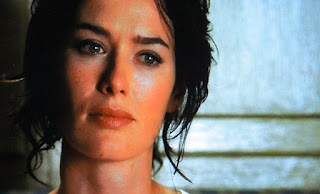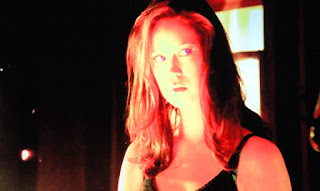-Cameron on the need to destroy all Terminator endoskeletons-


The latest installment of Terminator: The Sarah Connor Chronicles, Season One, Episode 6, Dungeons And Dragons, takes us to the future in the battle against the machines. The entry alternates between the present and the future and echoes the flashback approaches of the original The Terminator (1984) film.
This writer was immediately drawn into the sci-fi elements of this story's future popularized so beautifully in the original James Cameron film. Who can forget the treads of automated machines rolling over and crushing human skulls? The apocalyptic future of the Terminator universe can be quite immersive.

Not only do we explore this world through the eyes of Derek Reese, but we are introduced to future Kyle Reese.
We are even treated to the iconic final Kodak image of Sarah Connor with her German Shepherd made memorable by Linda Hamilton in the original film, but, here, reshot with Lena Headey in the image as Sarah Connor. So the series continues to play with the mythology and change things up offering us alternative glimpses of this version of events as they unfold. Even a future Andy Good takes responsibility for what has become of their future while working with the resistance.
Dungeons And Dragons (not to be confused with the game played by my teenage friends when I was a kid---man I just never got that) takes us into the tunnels glimpsed in the original film and so expertly filmed then by a relatively young upstart filmmaker that would become beloved in science fiction in Cameron (the name assigned to this series Terminator unit as played by Summer Glau).

The effects work in the episode, as Hunter Killers bear down upon the human resistance, is impressive when you consider the budgetary limitations in play. The computer backdrops are also exceptional for television if limited.
Cameron alludes to the recitation of script from James Cameron's earliest films describing herself. "Hyper alloy combat chasis. Cybernetic organism. Living tissue over a metal skeleton." And we meet future Cameron who works for the resistance. Unfortunately these units that act as friendlies, well, "sometimes they go bad, no one knows why." This explains Derek Reese's aversion to Cameron in the present.

There is one interesting new development concerning Cameron. Every suggestion is that Cameron's allegiance is to Sarah and John Connor. She is believed to be loyal to the end sent from the future to protect them despite Sarah's cold treatment of Cameron as nothing more than the "robot" she is.
But in Ep5, Queen's Gambit, there were two key intriguing moments in Cameron's development as a character.
First, at a technology show, several early era robots or machines are standing in contrast or juxtaposition to Cameron in a clever visual shot. Cameron takes note of one particularly advanced unit and quizzically is intrigued by its abilities. In effect, she considers her own development essentially from an early version of the cybernetic entity. She exhibits a self-awareness.

The second moment is when Cameron disables a Terminator unit removing the head bolt. We see a glimpse of something else. As the unit powers down and the lights in the unit dim, Cameron gives an almost sympathetic pause to the unit's shutdown to the plight of the machine. There is a brief moment where Cameron appears to exhibit empathy. While these machines are not human, but rather programmed, does the moment suggest the evolution of artificial intelligence to a level equal to an emotional response? If self-aware could it be Cameron, through the disabling of one unit, considers her own existence? These small moments always offer us the hallmarks of intelligent science fiction whereby we are asked to question action and motivation.

This question surrounding Cameron's motivations, as Terminators go, is alluded to again here in Dungeons And Dragons. Whilst disposing of a Terminator endoskeleton she converses with Sarah who orders her to dispose of "every last bolt." While the hand is missing from the endoskeleton, upon Sarah exiting the area we witness Cameron holding a bolt-like item she has chosen to retain and conceal. Not destroying the item once aain speaks to an act of near self-preservation. She demonstrates in a sense free will as she performs a willful violation of Sarah's exact directive. What does this mean? Is something nefarious in play internal to the machines? Is Cameron becoming self-aware? Or could it be Cameron is acting upon the instruction of future John Connor? This is a fascinating new undercurrent introduced to the series.

The episode effectively ties the future components of the story together with the present nicely coalescing the details surrounding time travel and the arrival of Derek Reese to the world of Sarah and John.
In effect, Derek sees the visit to the past as an opportunity to save Kyle by fixing the future. "We can fix all the mistakes."
Dungeons And Dragons is an allusion to the mental and physical imprisonment for Sarah and John Connor, the dungeons of the mind and body, as much as it alludes to the Reese boys' future struggle whilst the Dragons or Terminators knock at their door. All of it effectively influencing their future and present realities.

The series, too, is quite faithful in adapting the material here and pays considerable homage throughout the first season by building in actual script excerpts from the original film. Sarah narrates familiar territory as an example, "The machine is out there. It can't be bargained with. It can't be reasoned with. It doesn't feel pity or remorse or fear. And it absolutely will not stop ever until you are dead." Those words are nearly as memorable as the words recited by Roy Batty at the end of the film Blade Runner (1982). Is that not science fiction poetry and prose?

Dungeons And Dragons builds nicely upon the mythology for a strong Season One entry working as a solid complement to the strong showing of its predecessor Queen's Gambit. Barcoding humanity by the machines, the birthing of the machines, the skinning process. Season One continues to build on the evolution of the nuts and bolts behind the Terminator mythology. At the same time the series continues to weigh heavily on the human toll, the relationships and the impact of these killing machines on the future. More urgently the series explores Sarah and John Connor and how their lives, forced by fate to fight for the future, are affected every day.

Creator Josh Friedman describes the essence of the show as one where "it's really about the value of human lives. It's about these things that hate mankind, that come back to eliminate us. What are the depths, the lengths you will go to defeat them and still retain your humanity?" These explorations echo the running thread of a series like Battlestar Galactica (1978-1979) and the battle with the Cylons.
While killing the machine may seem an easy call, there is indeed a behavioral change within us to move to dark places and how does that behavior take its toll on humanity. T:TSCC aims to explore such themes. This is human nature. This is man and woman versus the machines.
Things are heating up and as Sarah's former love, Charlie Dixon channels, implanting yet another verse and homage to Terminator, "There's a storm coming." Indeed.




















No comments:
Post a Comment